|
Two meters under the narrow streets of Bodrum lies 5000 years of history. A few monuments
attest to this history: the castle, the Roman theatre, the Myndus Gate and the Mausoleum.
 The history of Bodrum in general The history of Bodrum in general
 Mausoleum Mausoleum
 Myndus Gate Myndus Gate
 The Castle The Castle
 Amphi theater Amphi theater
 A contemporary Bodrum Figure: Cevat Sakir A contemporary Bodrum Figure: Cevat Sakir

The ancient city of Bodrum (Halicarnassos, Halicarnassus) is thought to have been founded
around 1,000 BC by Dorian settlers from Greece. Later the city became part of the  Hexapolic Union, known as the Dorian league. According
to Hexapolic Union, known as the Dorian league. According
to  Herodotus, however, it was expelled
when a Halicarnassan contestant in a sporting contest insisted on keeping the trophy he had been awarded, instead
of dedicating it to God Apollo. Herodotus, however, it was expelled
when a Halicarnassan contestant in a sporting contest insisted on keeping the trophy he had been awarded, instead
of dedicating it to God Apollo.

The city was captured by the Lydians in the first half of the 6th century BC and then by the Persians in 546 BC
after which it was ruled by the Satrapy of Saird. In 386 BC, the Persians took complete control of the Carian region
(southwest Anatolia). Then in 377 BC  Mausolos,
the most famous of the Carian satrapies, took control of the region. He ordered the construction of many cities
and moved his capital from Milas to Halikarnassos. Mausolos enlarged his new capital by bringing in people from
other cities in the region and constructing new walls, palaces, theaters and temples. Mausolos,
the most famous of the Carian satrapies, took control of the region. He ordered the construction of many cities
and moved his capital from Milas to Halikarnassos. Mausolos enlarged his new capital by bringing in people from
other cities in the region and constructing new walls, palaces, theaters and temples.

However, the most important building in the city is/was the monumental tomb constructed for him by his wife, Artemisia
II, and from which we get the word ‘mausoluem’. Construction lasted five years and at the time of its completion
in 340 BC, it ranked among the Seven Wonders of the World.

After the rule of  Mausolos
and his family, in 334 BC, Halicarnassos was conquered by Alexander the Great
which later became a naval base for the Lagos Dynasty of Egypt. In 192 BC, the city became a Roman colony, and
in 88 BC was briefly ruled by the Pontus Kingdom. Mausolos
and his family, in 334 BC, Halicarnassos was conquered by Alexander the Great
which later became a naval base for the Lagos Dynasty of Egypt. In 192 BC, the city became a Roman colony, and
in 88 BC was briefly ruled by the Pontus Kingdom.

Halicarnassos fell to the Seljuk Turks in 1071 AD, and it was with the permission of Sultan Celebi Mehmet that
the Knights of Rhodes were able to construct Bodrum Castle – the Castle of St. Peter. The castle, with its English,
French and German towers is today the symbol of the town.

The city came under Ottoman rule in 1522 AD when Suleyman the Magnificent captured Rhodes and forced the knights
to move to Malta. Known as ‘Petrion’ after the Castle of St. Peter, this later became in Turkish ‘Bodrum’, the
name by which the town is known today.
The Mausoleum is Bodrums oldest antiquity and was built by Artemisia II in honour of her husband King Mausolos
( full story). It became
one of the wonders of the ancient world, Mausoleum still is the general term for a large tomb. The entire structure
stood at over 50 meters in height. The first reliefs from the full story). It became
one of the wonders of the ancient world, Mausoleum still is the general term for a large tomb. The entire structure
stood at over 50 meters in height. The first reliefs from the  Mausoleum
(full story) reached the British Museum in London in 1846, these included frescos and other objects. Mausoleum
(full story) reached the British Museum in London in 1846, these included frescos and other objects.
The Myndus gate
Located on the west side of Bodrum, this is one of the two entrances of ancient Halicarnassus. It was part of the
towns wall. The gate is named after the place Myndos because it faces the ancient Myndos place (now Gümüslük).

A big handshake should go first to the companies Ericsson and Turkcell, who sponsored the excavation
of Bodrum's town walls, which are a remarkable example of ancient Western Anatolia architecture.

Only some parts of the city walls remained until today. An important part of the town wall was the  Myndos Gate where the soldiers of Alexander (*the great*)
had a hard time to come into the town of Halicarnassus in 333 BC. After they captured the city they destroyed all
buildings except the Mausoleum, which was one of the seven wonders of the ancient world. Myndos Gate where the soldiers of Alexander (*the great*)
had a hard time to come into the town of Halicarnassus in 333 BC. After they captured the city they destroyed all
buildings except the Mausoleum, which was one of the seven wonders of the ancient world.

Extensive excavation and restoration has been done by the archeologists to bring this spot from ancient times to
be better realized now. It is expected that the whole restoration of the town wall of nearly 4,5 kilometers will
take four to five years to complete.

According to Arrianus, who describes this gate and and the siege of Alexander the Great in 334, this gate had originally
three towers (that's why it was described as 'Tripollion'). It was also mentioned that in front of the gate was
a ditch of 8 meters depth and 15 meters long. The middle part of the gate is totally destroyed now but ruins from
the two other parts still exist and consist of huge and heavy square stones.
Tombs were found here and opened by Newton in the last century. They dated back to Hellenistic and Roman times
and were made from burned clay.

Here - as nearly everywhere in Turkey Archeologists expect to find more remains underneath the rubble of 17 centuries
The most prominent feature of Bodrum is the castle of St. Peter.
|
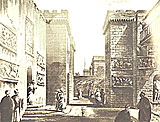
|
|
 on this old gravure you still can see
the frieses of the Mausoleum in the castle walls on this old gravure you still can see
the frieses of the Mausoleum in the castle walls

|
The castle's origins date back to the knights of St. John
This group of expatriates began in the 11th century with a church and hospital in Jerusalem. Although belonging
to he Catholic religion care was denied to no-one.
When the knights arrived they instructed their builders to remove all usable materials from the tomb of King Mausolos
as the castle construction began in the 1400's.

The knights refered to the town as Mesy not knowing that they where in the ancient Halicarnassus. The fortress
became known as the Castle of St. Peter, the Liberator, it served as the sole place of refugee for all Christians
on the West Coast of Asia during the time of the crusades. For over a century the castle served as a stronghold
in the knights community.
Under Turkish care the castle has undergone several uses including being a military base, a prison and a public
bath.
But now it is one of the finest museums in this region
see also video.
The Amphi-theatre
The theatre ( full story) is
another witness to the great past of Bodrum. Situated in the hillside over looking Bodrum this theatre whose capacity
is around 13.000 was built during te Carian reign in the Hellenistic age (330 - 30 BC.). The theatre consists of
three different sections: a place for the audience, a place for an orchestra and the stage. It became an open-air
museum after the excavations in 1973. full story) is
another witness to the great past of Bodrum. Situated in the hillside over looking Bodrum this theatre whose capacity
is around 13.000 was built during te Carian reign in the Hellenistic age (330 - 30 BC.). The theatre consists of
three different sections: a place for the audience, a place for an orchestra and the stage. It became an open-air
museum after the excavations in 1973.

A contemporary Bodrum Figure: "Fisherman of Halicarnassus"
Cevat Sakir Kabaagaçli, the scion of a prominent Ottoman family and Oxford don, was convicted in 1925 of
some obscure crime and exiled to Bodrum. Bodrum was then considered beyond the pale of the civilized world, a simple
and poor place that eked out a meager existence from the sea by fishing and sponge-diving. The journey was long
and arduous, with the shadows of bandits lurking in the hills; the last stretch of the route from Milas was passable
only on foot and muleback.
Cevat Sakir, who was to become the great raconteur of Turkish literature under the name "Fisherman of Halicarnassus,"
tells the story of his forced march in his memoirs. On a curve of the road, he reminisces, the sea "cracked
upon the horizon without warning like a vast blue thundering infinity." The sea dominated the town, where
it "infiltrated through alleys and courtyards with a shimmering transparent light." It "sparkled
to an incomprehensible depth full of yearning and beauty and terror." The air was "dry and bright as
if lit by an inner light." The town was "modest and dazzling white with straight lines that cut the sky's
blue with knife-like precision." People lived close to the basics of existence with simple direct passions
and the distilled wisdom of countless civilizations.
The exile fell in love with Bodrum and elected to remain there for most of the rest of his life. He became the
town's grand old man, introduced new fishing techniques, planted trees (the palms lining the quay are his) and
above all told the fantastic tales of an ancient Aegean civilization and of the passionate, broad-spirited, fatalistic
people of the sea. Two generations of Bodrum's youth grew up under his spell.
In the early 60s a group of the Fisherman's disciples from Istanbul began to visit him in Bodrum in search of aesthetic
ecstasy and spiritual purification. They included a classical scholar, the Turkish translator of Homer, two prominent
painters, a political philosopher, a socialist theorizer. They initiated the tradition of the "Blue Voyage" sailing into the Aegean for a few weeks on a simple boat and confronting
nature with as few amenities as possible. The late 60s, with its culture of the rejection of middle-class values,
swelled their ranks. This was a time of staying in fishermen's houses and paying for room and board with a bottle
of raki.
In the 70s, members of the middle class who were bold enough to experiment with the unconventional began to spend
vacations in Bodrum. The turning point arrived when the singer Zeki Müren, the ultimate impersonation of the
Turkish kitsch, announced his decision to settle in Bodrum. Around 1985, the number of tourists in town for the
first time exceeded that of the native. Bodrum became the principal vacation haven of western Turkey, with all
the conveniences and curses that ensue.
He also asked for the return of the Mausoleum parts to Bodrum in a letter adressed to the Queen of England, saying
that such exquisite works of art were not finding their true place under the foggy and grey sky of London.
The letter he received in response stated as following:
"Thank you for reminding us of the matter, We have painted the ceiling where Mausolos and the Mausoleum is
located in blue."

|

|
|
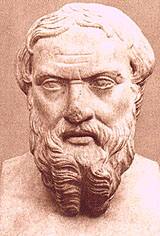
|
|

Herodot - In touristischen Broschüren vielzitierter Bürger des antiken Halikarnassos. Doch ein Geschichtsbewußtsein
der Bodrumer scheint es nicht zu geben, bis heute gibt es keinen Platz oder eine Straße, die den Namen dieses
Mannes trägt.

|
|
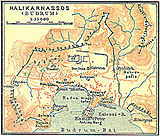
|
|
 Bodrum,
200 years ago Bodrum,
200 years ago

|
|

|
|
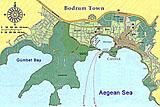
|
|
 Map of Bodrum today Map of Bodrum today
|
|

|
|

the Bodrum postcard
|
|

|
|

|
|
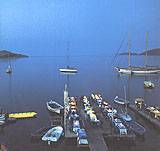
|
|
The Blue
Cruise starts in Bodrum



|
|

|
|

|
|
|
|
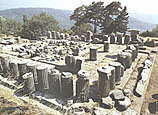
|
|
 Zeustemple Labranda Zeustemple Labranda

|
|

|
|
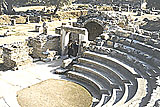
|
|
 Iassos - the story Iassos - the story

|
|

|
|

Die Bodrum Postkarte
|
|

|
|

|
|
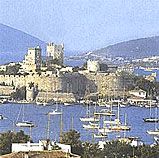
|
|
Landmark of Bodrum - the castle



|
|

|
|
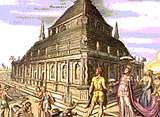
|
|
one of the many versions of the Mausoleum


|
|

|
|
|
Free Downloads

|
|
|
|
|